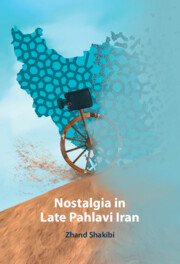Book contents
- Nostalgia in Late Pahlavi Iran
- Nostalgia in Late Pahlavi Iran
- Copyright page
- Dedication
- Contents
- Acknowledgements
- 1 Introduction
- 2 Those Were the Days
- 3 Nostalgia and the Late Pahlavi State
- 4 Nostalgic Triad
- 5 Love and Marriage
- 6 Mind the Generation Gap
- 7 The Hippies Are Coming! The Hippies Are Coming!
- 8 Mother’s Guest: Urban Nostalgia
- 9 What Were Those Days?
- 10 Law and Order
- 11 O’ The Ruthless Ones!
- Epilogue
- Select Bibliography
- Index
Epilogue
Published online by Cambridge University Press: 20 March 2025
- Nostalgia in Late Pahlavi Iran
- Nostalgia in Late Pahlavi Iran
- Copyright page
- Dedication
- Contents
- Acknowledgements
- 1 Introduction
- 2 Those Were the Days
- 3 Nostalgia and the Late Pahlavi State
- 4 Nostalgic Triad
- 5 Love and Marriage
- 6 Mind the Generation Gap
- 7 The Hippies Are Coming! The Hippies Are Coming!
- 8 Mother’s Guest: Urban Nostalgia
- 9 What Were Those Days?
- 10 Law and Order
- 11 O’ The Ruthless Ones!
- Epilogue
- Select Bibliography
- Index
Summary
In 1925, the Pahlavi era started amidst strong sentiments of temporally distant nostalgia among the literate class, intellectuals, and political figures for the civilizational grandeur and military puissance of pre-Islamic Iranian empires, Iran’s Golden Ages. These sentiments had emerged in the closing decades of Qajar rule given the deep discontent and uneasiness resulting from the stark contrast between these ages and the weak, wretched state into which Iran had fallen. Exemplifying this nostalgia in early official ideology were the dynastic name, Pahlavi, the name of the Persian language during the Sasanian period, the Pahlavi crown, modelled on that of Sasanian shahs, and systematic celebration of Ferdowsi’s Shahname. This distant nostalgia constituted a mobilizing force and historical justification for Pahlavi absolutism, which claimed it would return to Iran that grandeur and puissance through programmes of change from above.
- Type
- Chapter
- Information
- Nostalgia in Late Pahlavi Iran , pp. 351 - 368Publisher: Cambridge University PressPrint publication year: 2025

